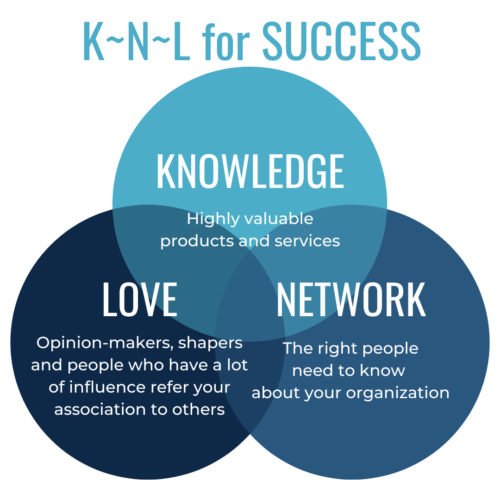FORMULA FOR BUSINESS EXCELLENCE
After completing this module, you will be able to:
1. Explain the elements in the Formula for Business Excellence.
2. Describe how to attract and retain top talent.
3. Define the attributes of a winning culture.
4. Explain how to have extreme member focus.
5. Describe how to execute innovation in a disciplined manner.
Learning Tip: Complete the Companion Guide as you watch the webinar.
If you haven't done so already, download the Companion Guide.
[progressally_media media_id='1']
The tasks below will be automatically checked off once you complete watching the video and taking the quiz.
[progressally_objectives]
THE FORMULA FOR BUSINESS EXCELLENCE
Watch the video above, entitled “How to maximize culture and member value in associations with John Spence,” to hear an explanation of the Formula for Business Excellence, which is:
(Talent + Culture + Extreme Member Focus) x Disciplined Execution = Business Excellence
Learn about each element of the formula below as you continue through the lesson.
TALENT
Factors for attracting and retaining top talent.
Click each factor to learn more.
CULTURE
Key Points about Culture
Culture = Cash
The members’ experience will never exceed your employees’ experience.
Key elements of a winning culture from the EMPLOYEE’S point of view
These are all atmosphere issues. They don’t cost anything to have a positive impact!
Click each tab to learn more.
Key Elements of a Winning Culture From the BUSINESS Point of View

Click each element below to learn more.
3 Key Ideas
Wow your customers internally and externally.
No surprises because people feel free to bring challenges/issues to the forefront.
Create an atmosphere where people celebrate small to BIG wins.
LEADERSHIP TRUST

 Consistently communicate that you’re competent and that you care.
Consistently communicate that you’re competent and that you care.
- High competency, low concern: Bright, but condescending. No respect or trust; they only care about themselves.
- Low competency, low concern: These leaders are not nice, and there’s no trust.
- Low competency, high concern: No trust to lead. They may be nice, but they don’t know what they’re doing.
- High competency, high concern: Consistently getting better, working hard and trying to improve. They do everything they can to improve as a leader from a position of wanting to serve and help other people.
EXTREME MEMBER FOCUS
Extreme Member Focus includes three concepts:
1. Voice of the Member
2. Moments of Truth
3. Word of Mouth
VOICE OF THE MEMBER
Whoever is closest to the member’s voice owns the marketplace because they understand the members' needs, fears, wants and desires best. Whoever listens the best will have the strongest loyalty and advantage over how members spend their time and money.
Own the voice of the member by offering things that serve them, help them and make them better.
Ideas for ways to understand the voice of the member include:
- Surveys
- VIP groups
- Special member’s groups
- Panels and social media
MOMENTS OF TRUTH
Member interactions that have to be done PERFECTLY every time to turn a member into a member evangelist: Someone who loves, shares and tells everyone to join your organization.
If the Moments of Truth aren’t done perfectly every single time, members will leave.
Key Points for your Moments of Truth
Click each factor for more information.

WORD OF MOUTH
Referrals drive membership: 48-74% of all purchasing decisions are made by word of mouth or word of thumb through social media referrals.

DISCIPLINED EXECUTION
Most associations have smart people and good ideas — but lack disciplined execution.
5 Levels of Accountability for Disciplined Execution
Clarity, Authority, Resources: The deliverables for the project need to be 100% clear, plus the project manager needs to have the appropriate authority and resources (timeline, budget, measurements, key performance indicators). The project manager also needs the appropriate level of decision-making without needing executive input.
Agreement: The project manager has to be able to recall and tell you what you want, how it’s measured, the timeline, and the necessary resources. They should write it out and sign that they accept 100% accountability and believe it’s a reasonable goal.
Track and Post: Track all major goals to ensure the timeline and budget are appropriate. The tracking needs to be highly visible with goals clearly outlined and easy to understand. The colors of a stoplight — green, yellow and red — are a common way to gauge the health of the project. There may be resistance among your team when you start reporting.
Coach, Train, Support: Coach, mentor, train, and support when deliverables are in yellow or need assistance. Give extra help and resources. Find out what you can do to help move the deliverable to better health.
Celebrate and/or Discipline: Celebrate success when deliverables are continually green. When metrics are being met, reward the team responsible. Reinforce positive behavior. Deal decisively with mediocrity. If deliverables are consistently yellow and red after coaching and mentoring and can’t get to an acceptable level, let the team member go. Failure impacts everyone negatively. If you allow someone to fail and nothing happens, then you’re telling everyone the tracking doesn’t matter.
CHECK FOR UNDERSTANDING
See if you understand the concepts by completing the quiz. Click Maximizing Culture and Member Value Quiz to begin.
[accessally_course_navigation prev_button='Previous' next_button='Next']
[progressally_note note_id='1' allow_attachment='no']
Share your progress!
[progressally_social_share type='facebook' share_id='1' post_id='42'][/progressally_social_share][progressally_social_share type='twitter' share_id='1' post_id='42'][/progressally_social_share][progressally_social_share type='email' share_id='1' post_id='42'][/progressally_social_share]
[progressally_progress_bar post_id="5774" width="100%" height="25"]
